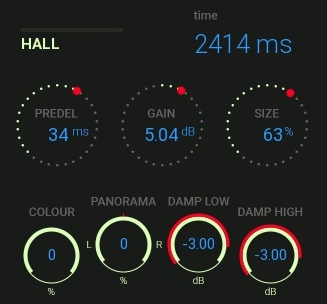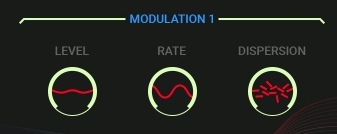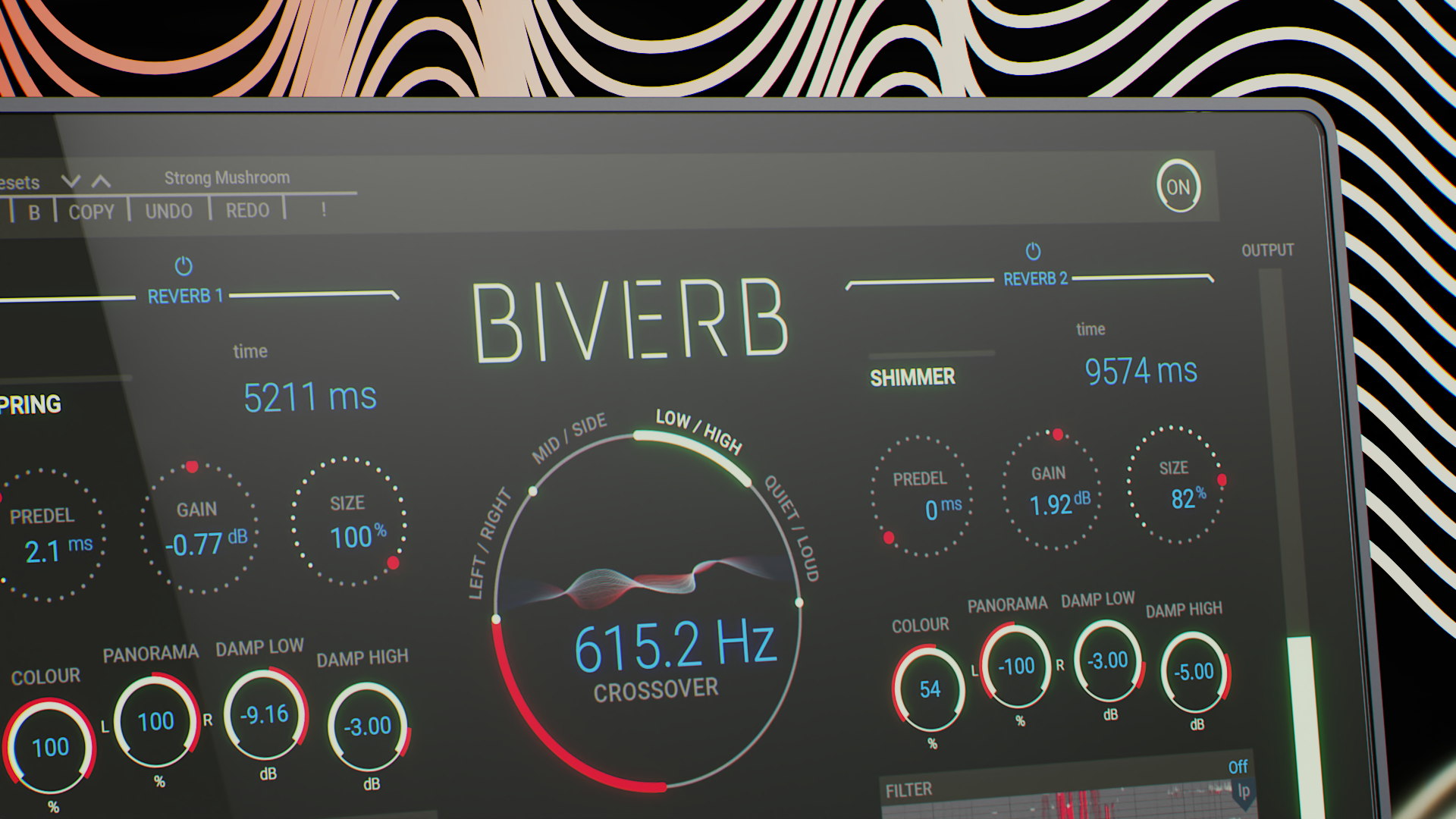Biverb Manual
Global parameters

Dry - Dry controls the level of the dry (non-effected) signal
Wet – Wet controls the level of the wet (effected) signal
Link (icon) – Links the Wet and Dry knobs to work simultaneously.
Mode - Mode controls the choice of the mode of Biverb. You can choose between L/R (left/right), M/S (mid/side – only works for true stereo signals), Low/High (split by frequency) and Quiet/Loud (loudness dB) mode
Crossover - Crossover controls the split of the crossover of the Low/High (choose a frequency to split your signals) and Quiet/Loud (choose the volume point to split your signals) modes
Reverbs

Biverb has two identical units that share the same controls. The unique effects of Biverb are achieved by applying different settings to different parts of your signal.
Reverb 1 (2) - Reverb 1 (2) enable the particular Reverb sections of Biverb
Type - Type controls the type of the algorithm of the reverb. You can choose between spring, room, plate, chamber, hall and shimmer
Predelay - Predelay controls the predelay time of the reverb. Predelay is the time before the reverb starts.
Gain - Gaincontrols gain of the reverb -/+24 dB
Time - Time controls the time of the decay of the reverb
Size - Size controls the size of the reverb.
Damp Low - Damp Low controls low dampening filter. It simulates absorption of the wall or air.
Damp High - Damp High controls high dampening filter. It simulates absorption of the wall or air.
Colour - Colour controls saturation of the delay and colour of the reverb
Panorama - Panorama controls panorama of the reverb. It is unavailable in the M/S and L/R modes.
Modulation

Mod Level - Mod Level controls the level of the modulation
Mod Rate - Mod Rate controls the speed of the modulation section oscillators
Dispersion – Dispersion controls the level of the fx, which is shattering the reverb sound
Ducking and filters

The Ducking function is designed to help the clean signal push through and not lose punch and attack. When used, it lowers the wet signal level automatically whenever a new dry signal comes to the plugin input.
Ducking - Controls the amount of wet signal suppression.
Time - Determines how fast the wet signal level will get to its original state.
HP - HP controls the minimal frequency of the signal going to the reverb
LP - LP controls the maximal frequency of the signal sent to the reverb unit
The Toolbar

A, B and Copy buttons - The plugin remembers two sets of settings, A and B. Clicking any of these 2 buttons switches between these 2 settings. The selected one is highlighted in red. This is a great way for A/B checking and selecting the best settings. "Copy" button copies the current settings to the other slot (if A is currently selected, the button will copy the current settings to slot B)
Undo and Redo buttons - All of us make a mistake from time to time, which is when these two buttons come in handy. Undo button reverts your last change, and Redo puts it back.
Panic - Hitting "!" stops the plugin processing and resets it.
Presets and the arrows - The plugin comes with a set of presets, which should do the trick for most cases or give you a good starting point when tweaking your sound. Access them using the right and left arrows or by clicking the preset field directly. You can save and manage your own presets there as well. In your computer, presets are stored in the following paths:
Windows: C:\Users\username\Documents\SoundeviceDigital\Biverb
MacOS X: HOME/Documents/SoundeviceDigital/Biverb
Right-Click Menu
Right-click anywhere in the plugin background with the right mouse button, and you will get access to the following features.
Change oversampling settings (Plugins that support oversampling only)
Scale GUI precisely by per cent.
Get the version info.
Access product web page, reach support and access online documentation.
Contact support
Open the presets folder (to add, arrange or delete presets manually)
Activate/Deactivate the plugin
Access Licence Manager (to activate or deactivate the plugin or several plugins at the same time)
Disable/Enable GPU Acceleration.
Disable/Enable Intelligent sleep on silence function that disables the plugin when no sound is on input or output to save the CPU power.
Right-click any control (knob, button) to access help for the particular parameter.
Double-click Menu
Some parameters let you access more accurate numeric settings by double-clicking the knobs.
Installation and maintenance
Installation is a quick and simple process involving downloading and using a standard installer on both platforms, Windows and Mac OS X. The installer places the plugins and presets into proper locations so that your DAW can easily find it. The plugin is available for all relevant interfaces: VST, VST3, AAX and AU. Note that on OS X since High Sierra you may need to restart your computer to make your DAW find new plugins.
If you find yourself in trouble, please contact us via support@unitedplugins.com.
Updating
Updating the plugin to the newest version is as simple as using the newest installer.
Uninstallation
Windows: You can either use the link to the uninstaller in the start menu by typing Biverb for example or it can be accessed via Control panels / Applications /
macOS X: First, delete the plugin files manually from :
AU: /Library/Audio/Plug-Ins/Components
VST: /Library/Audio/Plug-Ins/VST
VST: /Library/Audio/Plug-Ins/VST3
AAX: /Library/Application Support/Avid/Audio/Plug-Ins
Then, if you really want to get rid of all data created by the plugin, remove the following folders as well:
HOME/Documents/SoundeviceDigital/Biverb
HOME/Library/Application Support/SoundeviceDigital/Biverb
Note: Since OS X 10.7 (Lion), many folders are marked as hidden by default. To make them visible again in Finder, please follow this tutorial:
https://ianlunn.co.uk/articles/quickly-showhide-hidden-files-mac-os-x-mavericks/
Trial and activation
Biverb is initially in demo mode, which lets you evaluate the plugin. Try it in your mixing/mastering sessions and make sure it really does the trick. When ready, purchase a licence from our shop or any of our resellers. You will receive a so-called licence file, which you download to your computer. The plugin displays an ACTIVATE button when in trial mode. Click it and select the licence file. The plugin will check the licence and activate the licence on your computer. After you restart your DAW, the plugin will be activated and will work indefinitely without restrictions. You can use the plugin on all your computers.
Support
Now that you’ve taken the time to learn all about Biverb, enjoy and make your sound awesome! If our plug-ins helped you take your production to the next level, let us know; we’d love to hear from you and what you were able to create with our software.
If you encounter any problems, we offer free technical support for all registered users. Start with the frequently asked questions here:
http://www.unitedplugins.com/faq/Biverb
If you need further assistance, you can find our Customer Support contact form at:
http://www.unitedplugins.com/contact
You can also reach our support staff by e-mail at:
support@unitedplugins.com


